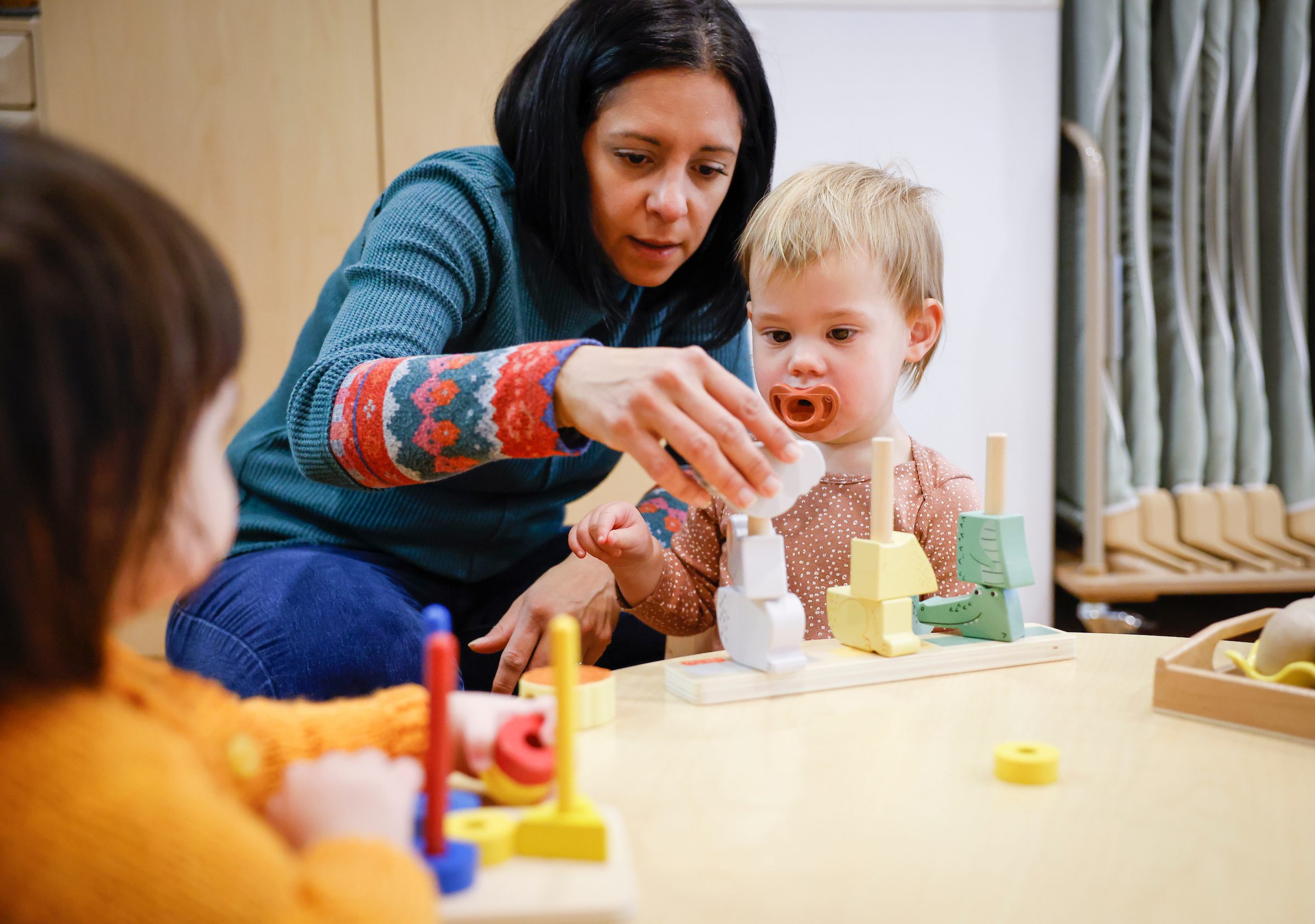Finding the right childcare or preschool program can feel like one of the biggest decisions you’ll make as a parent. You want a safe, nurturing place where your child can learn, grow, and build confidence, but you also need care that fits your family’s schedule, budget, and values.
We hope that the following guide helps you navigate finding the right program for your family. From understanding the diverse types of care and program philosophies to knowing what to look for in quality care, we hope this helps you feel confident that you can find a program where your child will thrive.
CHAPTER 1: Understanding Your Childcare Options

Types of Childcare
Every family’s situation is unique, and so are your childcare options. Understanding the main types of care will help you match your needs to the right environment.
1. In-Home Care (Nanny or Babysitter in Your Home)
In-home care takes place in your own home and is typically one-on-one. Many parents choose this option for infants or children who need extra attention or a familiar environment.
Pros
- Personalized one-on-one attention
- Child stays in a familiar environment
- Flexible schedule and routines
Cons
- Often the most expensive option
- Limited socialization with peers
- Quality depends entirely on the caregiver
- No built-in backup coverage
2. Family or In-Home Daycare (At Someone Else’s Home)
These programs are run from a caregiver’s home and typically serve small groups of mixed-age children.
Pros
- Smaller group size and flexible routines
- Often lower cost than center-based care
Cons
- Limited hours and closures during provider illness
- Fewer structured learning materials or resources
- Quality varies widely based on licensing and experience
- No substitute staff/backup care in many programs
- Not always licensed or regulated
3. Childcare Centers or Daycares
Center-based care serves infants through preschoolers in structured classrooms, usually with age-specific curriculum and trained teachers. These programs balance play, learning, and routine and often provide school-readiness experiences.
Pros
- Licensed and regulated
- Trained staff and clear safety protocols
- Consistent hours and reliable coverage
- Structured activities and developmental goals
Cons
- Larger group sizes
- May feel less personal than in-home environments
4. Private Daycare and Preschool Programs
Private preschools and daycare centers often go beyond basic licensing and include enrichment programs, smaller class sizes, and specialized curricula such as Montessori, Reggio Emilia, or Cadence Education’s Ascend Curriculum®.
Pros
- Smaller ratios and personalized instruction
- Play-based learning that builds developmental skills
- Social-emotional learning emphasis
- Strong family involvement
- Licensed and often accredited or rated at higher standards
Cons
- Higher tuition
- Admissions may be competitive or limited
Types of Preschool Philosophies
Preschools vary widely in philosophy and teaching style. Understanding these approaches helps you choose a program that aligns with your child’s personality and your family’s values.
| Type | Description | Strengths |
| Montessori | Self-paced learning using sensory materials | Independence and focus |
| Reggio Emilia | Project-based learning driven by curiosity | Problem-solving and collaboration |
| Parent Co-Op | Parents help manage and participate in classrooms | Community and involvement |
| Play-Based / Hands-On | Learning through guided play | Creativity and social-emotional growth |
| Waldorf | Art, rhythm, nature-focused environment | Imagination and empathy |
| Faith-Based | Spiritual values integrated with early learning | Moral grounding and belonging |
What’s the Difference Between Preschool and Pre-K?
Preschool typically serves ages 3–4 and focuses on social-emotional growth and learning through play. Pre-K serves ages 4–5 and introduces more structured academics and kindergarten readiness.
CHAPTER 2: The Quest for Quality

Finding the Right Childcare Fit: A Checklist
- Unmaintained organization and cleanliness
- Hesitant to share state license
- Activities not supporting development
- Lack of open communication
- High staff turnover or limited experience
- Consistent negative parent reviews
CHAPTER 3: Choosing the Right Fit for Your Family

Finding the right childcare is not only about choosing a program — it’s about matching your family’s needs, priorities, and long-term goals.
Creating Your Ideal Schedule
Full-Time Care (8–9 hours/day)
- Provides consistency and structure
- Encourages social and cognitive development
- Ideal for working parents with set schedules
Part-Time or Half-Day Care
- Easier adjustment for new learners
- Balance between home and school time
- Ideal for families easing into school routines
Before- or After-School Care
- For school-age children outside standard class hours
- Enrichment and homework support
- Safe and consistent routine for working parents
Flexible or Drop-In Care (like FlexiPass)
- Adaptable scheduling for variable work weeks
- Structured environment without long-term commitment
Is Your Child Ready for Preschool?
Every child’s readiness for preschool goes beyond age alone — it’s about confidence, curiosity, and emotional resilience.
Choosing a Childcare Option for Your Family
Choosing childcare is never one-size-fits-all. When you visit programs, ask questions, observe the environment, and look for strong communication with families, the right choice becomes clearer.
Ready to take the next step? Find a Cadence Education school near you to learn more about programs, schedule options, tuition, and availability.




